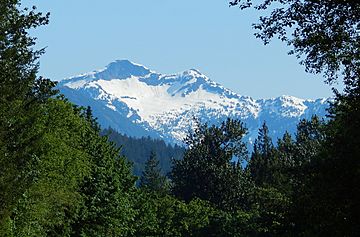The Roost (Washington) facts for kids
Quick facts for kids The Roost |
|
|---|---|

The Roost seen from North Cascades Highway
|
|
| Highest point | |
| Elevation | 6,705 ft (2,044 m) |
| Prominence | 865 ft (264 m) |
| Geography | |
| Parent range | North Cascades |
| Topo map | USGS Mount Triumph |
| Type of rock | Granodiorite |
| Climbing | |
| First ascent | July 12, 1966 by John Roper, Taffy Roper |
| Easiest route | Scramble |
The Roost is a tall mountain peak in the North Cascades mountain range in Washington state, United States. It stands 6,705 feet (about 2,044 meters) high. This mountain is part of the Picket Range, which is a smaller group of mountains within the North Cascades.
You can find The Roost inside North Cascades National Park and the Stephen Mather Wilderness. It's located about one mile north of another mountain called Mount Ross. The Roost is special because it rises very steeply from the land around it, even more than its actual height might suggest. The first people to climb The Roost were John and Taffy Roper on July 12, 1966. The mountain's water, from rain and melting snow, flows into the Skagit River.
Contents
What is the Weather Like at The Roost?
The Roost is in a place with a "marine west coast" climate. This means it gets a lot of rain and snow, especially in winter. Most of the weather comes from the Pacific Ocean. These weather systems travel east towards the Cascade Mountains.
How Mountains Affect the Weather
When air from the ocean hits the tall Cascade Mountains, it's forced to rise. As it goes higher, the air cools down and drops its moisture. This causes a lot of rain or snowfall on the western side of the mountains. This process is called Orographic lift.
Summer and Winter Weather
Because of the ocean's influence, the snow here can be very wet and heavy. This can make avalanches more likely. In winter, it's often cloudy. But in summer, high pressure systems over the Pacific Ocean usually bring clear skies.
How Was The Roost Formed?
The North Cascades, where The Roost is located, have very rugged and sharp peaks. They also have deep valleys carved out by glaciers. The amazing shapes of these mountains and the big changes in height happened over millions of years. These changes also led to different climates and types of plants in the area.
The Story of Mountain Building
The Cascade Mountains started forming millions of years ago, during the late Eocene Epoch. This happened because the North American Plate (a huge piece of Earth's crust) was slowly moving over the Pacific Plate. This movement caused a lot of volcanic activity.
Also, smaller pieces of Earth's crust, called terranes, crashed into North America. These collisions helped create the North Cascades about 50 million years ago.
The Role of Glaciers
During the Pleistocene period (the Ice Age), huge sheets of ice called glaciers moved across the land many times. As they moved, they scraped and shaped the landscape, leaving behind rocks and debris. The "U"-shaped valleys you see in the mountains today were carved out by these glaciers.
The combination of the land being pushed up (called uplift) and cracks forming in the Earth's crust (called faulting), along with the glaciers, created the tall peaks and deep valleys of the North Cascades.



